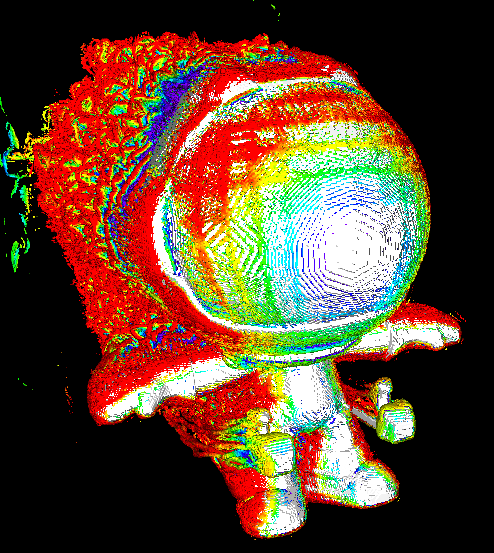Somebody save my CPU. made with Krita™
I’ll take any excuse I can get to dump my perspective here. I love AV1 for video and I hate AVIF with a passion. Every video that I create is delivered in AV1, because it is incredibly useful, versatile and extremely powerful. Right tool for the right job.
Not that there’s anything inherently wrong with AVIF other than it tries to force a video codec into something that is that it is not meant for, namely a still image codec. I hate the drama around it that Google has created. Because the stupid cunt that created AVIF is an emotional slime, he tried to block JPGXL, a competitor for AVIF, from having official support in the Google Chrome browser. And because Google Chrome is a monopoly in the browser market, CDNs and other people who’d like to use JPGXL, since it has significantly better all around features for still images, cannot use it now.
Features of JPEG-XL:
- better still image compression than AVIF
- lossless JPEG transcoding
- progressive image loading
- universally usable from capture to delivery
- layer support with 4,099 channels
- CMYK Compatible
- 32 bits per channel
- no limitations on image size or colour precision
And all of that is thrown away because one bastard has his feelings hurt by user choice.
Thank you for listening to my useless TED Talk.
Edit: While I sound extremely black-pilled about this, because monopolies are bad, the positive thing is that it’s gaining traction, finally. Apple has fully embraced it some time ago. Now Microsoft Windows supports it natively as well. Literally the only missing piece is the browser. While Safari, thanks to Apple, - never thought I’d say that - now supports JPEG XL natively, Firefox and Google Chrome do not as of right now. So the browser is literally the last missing link for full native support. Also, I’d wish for the people at Mozilla to stop letting themselves be cucked by Google. But JPEG XL is around the corner, luckily, because sooner or later they will be forced to use the modern format to stay competitive, like Samsung already does for their phone cameras. Still salty about the attempt, though.
Thank you for your TED Talk. I had no idea about the creator of AVIF or anything, BUT, I still really like that I can just use the same knowledge when it comes to transcoding jpegs/whatever to it. It uses the same codec, same parameters, supports animations, is like 1/100th the size of gifs…
I guess webp can do that latter part as well, but having a single tool able to do these things is neat in my opinion. (Please don’t come at me, systemd haters)
I think jxl also supports waaaaay higher resolutions and everything. So yeah, fair argument that I’m not, in any way, against.
Compression and accessibility are just really fascinating things to me, and I’m sure once the next huge, well-supported thing, comes around, so will I.Yes, and I agree with you. People should have choice of what format they use because different people have different needs.
I don’t hate AVIF inherently for its technology. I hate it for what it stands for. Namely, megacorporation Culture. One rogue manager has their feelings hurt and everyone bends over to accommodate them. Google has a fully SIMDified Rust decoder for JPEG XL that is fully standard compliant. But it doesn’t go into Chrome, because everyone just parrots the one guy that once made up some lie about it not “having public interest”. Best example is Google Interop 2025 not taking in JPEG XL. Literally every graphics software on the planet supports it, as well as multiple newspapers and CDNs want to use it, and I don’t mean the newspaper next door, I mean newspapers like The Guardian and CDNs like cloudflare. You can call Apple a lot, but the jpeg-xl implementation is some objective good for computing, Microsoft is slowly but surely rolling out support in Windows as well. Literally the only missing link in the chain is the Google Chrome browser, because it’s a monopoly.
And with that, I refuse to use it. Because if I were to use it and pump the numbers for AVIF, I would reinforce the blockade. Therefore I just can’t, even though the technology is very useful and that’s just another side of the Google Monopoly.
I converted most of my images to .jxl. It’s been pretty nice.
I wonder how we’re feeling for HEIC? Any drama/pros/cons I should know of? As AAPLs weight is behind, I wonder if we’ll get browser wars for this decades’ image formats.
HEIC faces a few struggles with adoption:
- It’s patent encumbered.
- It’s not free as in “free beer”, someone has to pay for it.
- It’s not free as in “free speech” - you can’t use, modify, and distribute software or formats without restrictions due issue #1.
AV1 and AVIF don’t have any of these issues –someone correct me if I’m wrong or missing something– so anyone is able to include/distribute the software and modify to their needs.
Ahh I see. I’m curious what the future holds lol
ldk, avif looks really good at the really high compression ratios. My problem with it is that usually it includes lots of details, except those details weren’t the actual details of the original image. It just kinda hallucinates them
Also ofc the unlimited layers, great lossless mode, and high color depth etc would still make jxl a better universal choice, but avif just looks better at the ultra low end
Not only is everything smaller, but the codec looks better. Compression artifacts when AV1 is really pushing it at lower bitrates are more like… pointillism? They resemble grain instead of the fuzzy squares you can get with 264 or 265, and it is especially better in dark scenes.
But it looks much worse at higher bitrates. H265 can get decent bitrates and have no visible difference from the original. AV1 loses a bunch of quality right out of the gate. If you are wanting to archive footage I think h265 is much better.
I don’t disagree about archiving. Though for a local collection, I think the space savings of AV1 are worth it.
Especially for grainy footage, which is extra costly in h265. The noise analysis and synthesis in AV1 is killer, IMHO. But of course… it’s not the same noise.
Hard drives are cheap and are only getting cheaper! If you are talking about proxy media, AV1 might be good for that with fast enough hardware support.
The noise synthesis thing is interesting. I have played with it, and it definitely works as advertised, but I’m not sure how I feel about relying on it.
The newer iPhone models actually capture their images as JPEG XL and they have retired their HEIC images. All of Apple’s software has full native support for JPEG XL as well.
are you archiving it until the patents expire? I use AV1 because of the license
I’m not really worried about the licensing of the codec I use for my personal archive. Even if I was worried, I would use h264 or VP9 before I used AV1.
deleted by creator
Ah, but are you using aomenc, SVT-AV1 or rav1e? Or one of the forks maybe?
I’ve tried all three! SVT flies in comparison to AOM on my 5800X.
Still playing around with ffmpeg settings, film grain synthesis and planning on properly checking out av1an.
I just love the codec so much, tiny bitrates but still beautiful. Then I learned .avif uses the same libraries as well and takes up like 1/10th of what my pngs do. (played around with webp/m before, pretty impressed with that as well…)
Wonderful stuffIf you have lots of jpgs you can losslessly reencode them to jpegxl and make them ~20-30% smaller (or absolutely shrink them with barely any noticable quality loss)
Same here, I wonder why SVT is not included with ffmpeg’s standard compile flags. Licencing?
The era of decent full HD movies on CD has come, finally a use for all my CD-R spindles!
av1an with its dark scene boost/per scene tuning is the best.
It works with x265 (or hardware encoders) too.
noob here
is DAV1D a thing as well ?
That’s a decoder for AV1. That allows you to play AV1 files, but it can’t create new AV1 files.
thanks ! 👌👌
Disk is cheap, just make everything mpeg2.
bring back .3gp to share with your classmates
I tried AV1, but it seems to work really poorly for compressing film grain which is my main usecase (movies).
I realise you can add fake film grain, but that’s not really my thing.
I’m sure it’s great for video game footage or low grain modern video, but that’s not what I need it for.
For now, I’ll likely stick with x265.
I could be wrong, but isn’t the idea that it removes the film grain to aid compressing the ““actual”” image behind the grain, and then the player adds the grain back in during playback?
The way you say it makes it sound like you want to compress the grain itself, and that sounds to me like a “I like the vinyl crackle in my digital media” take. Not that that’s a bad thing, everyone has preferences, but it’s also unlikely that AV1 (or any codec for that matter) was designed with the preservation of accurate film grain in mind.
That’s more or less what I’m saying yes, I do like the original film grain look of movies, and often attempts to remove it removed detail, making things look smudgy.
As for if no codec is designed for this, Blu-Rays preserve film grain, often very well, and they use x265. Granted they do this partially by brute force by having a bit rate of 30mbps+, but I’ve found that you can quite easily reduce that but rate to 12mbps and still preserve most film grain reasonably well. Especially if you use h265, the CPU version (NVENC is nowhere near as good with grain).
By comparison, with my brief stint with AV1 I found even maxing out the settings did not seem to preserve film grain. I guess the codec is inherently heavy handed, which is fine for what it’s intended for.
On film grain movies x264 can work, but then you typically need 20-50% more space for the same quality.
Yeah, it does feel like AV1 is tuned for higher compression. Hence its explicitly designed to try and denoise the grain away then replicate it.
To be clear, I’m with Pyro here (I just denoise grain away with a BM3D-V prefilter), but TBH I’d rather keep the raw rips at such high bitrates anyway.
deleted by creator
I’m no expert on the grain side, but Netflix had a nice writeup about its power.
https://netflixtechblog.com/av1-scale-film-grain-synthesis-the-awakening-ee09cfdff40b
I also heard that when you use film grain, you should disable the denoising done on the output to properly preserve detail in the encoding. Which depends on the encoder, but should generally be possible on the ones that do film grain.
But it might not be as good for artistic film grain that doesn’t fit normal “grain” in videos.
Why didn’t it fully embed the avif 😭
Edit 1: Might be just jerboa… Yahaw it’s investigation time.
Edit 2: Shows up fine on Lemmy-ui, Photon, Raccoon but not Jerboa and Thunder!In Voyager, everything works.
deleted by creator
FINALLY MY KINDA WOMAN
GPU acceleration is your friend :D
Software encoders are better for archiving as they are more efficient with their bitrate. You either get better quality with the same size or a smaller file than hardware encoders.
What if I offload it to my 487?
The 487 was just a full 486DX with a pin that told the motherboard to deactivate the soldered-on 486SX.
Cries in amdgpu
Shut up and -crf 0 me.
Let’s Jellyfin and chill
Tdarr.
I think FileFlows is better. I used tdarr for a few years, but I couldn’t get back into it after I had an m.2 burn itself out and I didn’t have good backups. I tired to set it back up and didn’t have enough patience to get it working again, and FileFlows was a drop in replacement that required minimal setup to get everything running again.
I haven’t seen that one. Tdarr used to be more work to get going with classic plugins, but with Flows its really intuitive and I’ve codified my flows into the helm chart I deploy it with so I don’t need to think about it. Its all in git and commented well.
Huh… FileFlows does a lot more than video and music though… interesting.
Eh there are a couple of things I dislike, though the UI is very nice looking and there are lots of features. Closed source, no lifetime option and tiered subs… that all puts me off a tool pretty quickly these days. I’ve lost the ability to trust anything that does not have open code due to the never ending and constant corporate enshittification and underhanded tracking.
That’s legit. I haven’t needed more than just a single processing node and it does the job rather well, so I’ve been fine with it (if rather annoyed by the business model they went with). I may give tdarr another go and see if it’s still pulling teeth to get my conversion pipeline reconfigured.
wow that’s bad ass, can we game on that ? What about running private-ish AI ?
but… HEVC?
There are still a lot of issues with adaptation of HEVC, especially with chromium based browsers on linux. Probably due to the patent fees or… whatever.
https://forum.endeavouros.com/t/hevc-support-and-cpu-load-in-brave-or-vivaldi-browser/72984
https://github.com/brave/brave-browser/issues/40101
This isn’t just a Brave issue, but affects basically all Chromium forks other than Thorium and… the other one I forgot the name of lol.
I can’t play any of the example hevc encodes, regardless of used flags/arguments. Vaapi set up correctly, and working everywhere else.BUT, for the one person on here with the same issue, using Jellyfin. Thorium browser gets updated once in a blue moon, but does have a workaround for HEVC decoding, and if you don’t wanna use that, Jellyfin Media Player seems to be using mpv as the player backend, doesn’t seem to be just an electron wrapper, and works great.
Furryfox works fine too.I’m using MX Linux and Firefox, I’ll test the browser. But using VLC it’s no problem here.
Yeah, external players like mpv and vlc are perfectly fine. Works on FF for me too. Seems like the issue pops up every couple of months with droves of people posting on random forums all around.
I did a comparison of AV1 vs h265 on a handful of video files I have in different styles. H265 seemed consistently better. AV1 just crushes the quality way too much.
This is what I subscribe to lemmy for.
Just wait until you discover vapoursynth.














